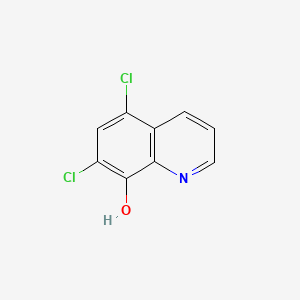D0844 | chloroxine
| Toxicity | Dose | Time | Species | Model | Method | Action | Positive criterion | Reference |
|---|---|---|---|---|---|---|---|---|
| MEMBRANE POTENTIAL | 10.59±1.22 | human | qHTS-HepG2 | MMP assay | decrease | IC50 | 163 | |
| MEMBRANE POTENTIAL | 9.75 | human | HepG2 | MMP assay | decrease | IC50 | 163 | |
| MEMBRANE POTENTIAL | rat | hepatocytes | MMP assay | Negative | IC50 | 163 | ||
| GLUCOSE GALACTOSE IC50 RATIO | 300.0 ± 0, 300.0 ± 0, 1, 300.0 ± 0, 300.0 ± 0, 1 | 4hr | H9c2 cells | high-glucose–galactose cell viability assay with JC-1 mitochondrial membrane potential and ATP-depletion assays (CellTiter-Glo reagent ). | Negative | glucose/galactose IC50 ratio (JC-1 IC50 in glucose, JC-1 IC50 in galactose, JC-1 glu/gla, ATP IC50 in glucose, ATP IC50 in galactose, ATP glu/gla ) | 50 | |
| Pictogram | Signal | Statements | Precautionary Statement Codes |
|---|---|---|---|
  |
Danger |
Aggregated GHS information provided by 47 companies from 6 notifications to the ECHA C&L Inventory. Each notification may be associated with multiple companies. H302 (89.36%): Harmful if swallowed [Warning Acute toxicity, oral] H315 (97.87%): Causes skin irritation [Warning Skin corrosion/irritation] H318 (87.23%): Causes serious eye damage [Danger Serious eye damage/eye irritation] H319 (10.64%): Causes serious eye irritation [Warning Serious eye damage/eye irritation] H335 (95.74%): May cause respiratory irritation [Warning Specific target organ toxicity, single exposure Respiratory tract irritation] Information may vary between notifications depending on impurities, additives, and other factors. The percentage value in parenthesis indicates the notified classification ratio from companies that provide hazard codes. Only hazard codes with percentage values above 10% are shown. |
P261, P264, P270, P271, P280, P301+P312, P302+P352, P304+P340, P305+P351+P338, P310, P312, P321, P330, P332+P313, P337+P313, P362, P403+P233, P405, and P501; (The corresponding statement to each P-code can be found at the GHS Classification page.) |
| Organism | Test type | Route | Dose (normalized dose) | Effect | Source |
|---|---|---|---|---|---|
| rabbit | LD50 | oral | 160mg/kg (160mg/kg) | "Handbook of Analytical Toxicology," Sunshine, I., ed., Cleveland, OH, Chemical Rubber Co., 1969Vol. -, Pg. 33, 1969. | |
| rat | LD50 | oral | 660mg/kg (660mg/kg) | "Handbook of Analytical Toxicology," Sunshine, I., ed., Cleveland, OH, Chemical Rubber Co., 1969Vol. -, Pg. 33, 1969. | |
| dog | LD50 | oral | 2250mg/kg (2250mg/kg) | "Handbook of Analytical Toxicology," Sunshine, I., ed., Cleveland, OH, Chemical Rubber Co., 1969Vol. -, Pg. 33, 1969. | |
| 2I8BD50I8B | 5,7-Dichlor-8-hydroxychinolin | 5,7-Dichlor-8-hydroxychinolin [German] |
| 5,7-Dichloro-8-hydroquinoline | 5,7-Dichloro-8-hydroxy-quinoline | 5,7-Dichloro-8-hydroxyquinoline |
| 5,7-Dichloro-8-hydroxyquinoline, 99% | 5,7-Dichloro-8-oxine | 5,7-Dichloro-8-oxyquinoline |
| 5,7-Dichloro-8-quinolinol | 5,7-Dichloro-8-quinolinol, 99% | 5,7-Dichlorooxine |
| 5,7-Dichloroquinolin-8-ol | 5,7-Dichloroxine | 5-21-03-00286 (Beilstein Handbook Reference) |
| 773-76-2 | 8-QUINOLINOL, 5,7-DICHLORO- | 8-Quinolinol,7-dichloro- |
| A9795 | AB00052323-08 | AB00052323_09 |
| AB00052323_10 | AB2000325 | AC-4820 |
| ACMC-209p9h | AK-89722 | AKOS000271338 |
| ANW-37011 | AS-229 | BDBM32147 |
| BIDD:GT0763 | BRD-K17075857-001-06-9 | BRN 0153606 |
| BSPBio_002711 | C9H5Cl2NO | CAS-773-76-2 |
| CCG-40039 | CCRIS 5751 | CHEBI:59477 |
| CHEMBL1200596 | CHQ | CPD000312779 |
| CS-2324 | CTK3J5578 | Capitrol |
| Capitrol (TN) | Capitrol Cream Shampoo | Capitrol Cream Shampoo (Salt/Mix) |
| Chlofucid | Chlorohydroxyquinoline | Chloroxine (USAN) |
| Chloroxine [USAN] | Chloroxyquinoline | Chlorquinol |
| Clofuzid | D03472 | D0412 |
| DB01243 | DSSTox_CID_2801 | DSSTox_GSID_22801 |
| DSSTox_RID_76734 | DTXSID5022801 | Dichlorohydroxyquinoline |
| Dichloroquinolinol | Dichloroxin | Dikhloroskin |
| DivK1c_000578 | EINECS 212-258-3 | Endiaron |
| F0918-0943 | FT-0623709 | HMS1923K05 |
| HMS2092N04 | HMS2609A16 | HMS3259E17 |
| HMS3655G16 | HMS3712O06 | HMS501M20 |
| HY-B0295 | IDI1_000578 | KBio1_000578 |
| KBio2_001914 | KBio2_004482 | KBio2_007050 |
| KBio3_002211 | KBioGR_001068 | KBioSS_001914 |
| KS-00000FNW | KSC495K7R | LS-142531 |
| MCULE-3987057340 | MLS000681736 | NC00505 |
| NCGC00095264-01 | NCGC00095264-02 | NCGC00095264-03 |
| NCGC00095264-04 | NCGC00095264-05 | NINDS_000578 |
| NSC 3904 | NSC-3904 | NSC-758398 |
| NSC3904 | NSC758398 | Oprea1_486275 |
| Pharmakon1600-01503202 | PubChem21919 | Q12029435 |
| Quesyl | Quinolor | Quixalin |
| REGID_for_CID_2722 | RTR-024734 | SAM002554895 |
| SBB039926 | SBI-0051782.P002 | SC-75357 |
| SCHEMBL3350 | SMR000312779 | SPBio_000813 |
| SPECTRUM1503202 | SQ 16401 | SR-01000747474 |
| SR-01000747474-2 | SR-01000747474-3 | ST24029249 |
| ST50160577 | STK075368 | SW198618-2 |
| SY016017 | Spectrum2_000687 | Spectrum3_001156 |
| Spectrum4_000744 | Spectrum5_001444 | Spectrum_001434 |
| TG2-36-1 | TR-024734 | TRA0059012 |
| Tox21_111494 | Tox21_111494_1 | UNII-2I8BD50I8B |
| UNII-Z7Z4BX535U component WDFKMLRRRCGAKS-UHFFFAOYSA-N; | UPCMLD0ENAT5752182:001 | W-104320 |
| WDFKMLRRRCGAKS-UHFFFAOYSA-N | ZINC1131 | chloroxine |
| cid_2722 | component of Capitrol Cream Shampoo | dichloroquine |
| s1839 |

